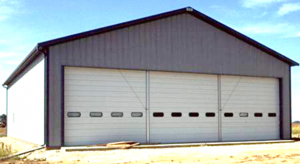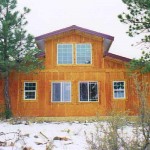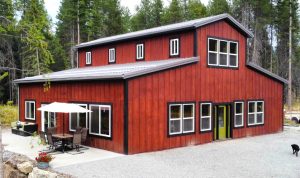This is part 1 of a two part series – I know it’s long, but bear with me – this is too important to divide it up into too many “pieces”. Good stuff here – read on:
 The information below is excerpted from the International Building Code (IBC) and based upon information provided by the American Wood Council. It is meant to be a start towards understanding how the Code applies to post frame buildings, but does not necessarily cover every aspect. The Planning, or other similar, Department which governs a particular jurisdiction should always be consulted as the final authority.
The information below is excerpted from the International Building Code (IBC) and based upon information provided by the American Wood Council. It is meant to be a start towards understanding how the Code applies to post frame buildings, but does not necessarily cover every aspect. The Planning, or other similar, Department which governs a particular jurisdiction should always be consulted as the final authority.
Use and Occupancy Classification
Building Code requirements are dependent on the appropriate classification of the building or structure or current occupancy. IBC Group “A” occupancies are divided into five subcategories. Group A-1 includes fixed seating occupancies for viewing performing arts and motion pictures. Group A-2 includes buildings in which food and drink consumption occurs, such as restaurants, banquet halls, bars and nightclubs. Group A-3 includes worship, recreation, amusement and other assembly uses not included in the other groups. Group A-4 includes indoor arenas, skating rinks, swimming pools and tennis courts. Group A-5 includes outdoor grandstands, stadium and amusement park structures.
Type V Construction for Post Frame Buildings
Permits the use of wood for structural elements, including structural frame members, bearing walls, floor and roof construction, as well as non-bearing elements such as exterior walls and interior partitions. It is further defined as Type VA (all interior and exterior load-bearing walls, floors, roofs and all structural members are designed or protected to provide a minimum one-hour fire-resistance rating) and Type VB (no fire resistance rating is required).
Type III Construction for Post Frame Buildings
Requires exterior walls to be noncombustible material or FRTW (Fire Resistant Treat Wood) having a minimum two-hour fire-resistance rating. All other building elements are permitted to be wood or other approved materials. Type IIIA construction needs to provide a minimum one-hour fire-resistance rating for all building elements and Type IIIB construction does not require any fire-resistance rating other than the exterior load-bearing wall.
Allowable Heights and Areas for Type III and V Construction
Under the IBC wood buildings are allowed to have areas and heights which were roughly equivalent to the largest buildings which were permitted for each construction type under one or more of the previously existing codes. In the past dozen years, the number of buildings which qualify for unlimited area under the special provisions of Section 507 has expanded. Special allowances for various post frame building features such as sprinklers or FRTW continue to be added. The size limitations for pole buildings are more determined by structural considerations than code limitations.
General building height and area allowances are given in Chapter 5 of the IBC. Height and per-story area limitations are shown in the Table 503 excerpt (Figure 5) and are based on occupancy and type of construction. These area and height limitations are unmodified and can be significantly increased based on certain provisions of the code.
|
Group A |
Type of Construction |
||||
|
Type III |
Type V |
||||
|
A |
B |
A |
B |
||
|
Height (ft) |
65 |
55 |
50 |
40 |
|
|
Stories |
|||||
|
Area (A) |
|||||
|
A-1 |
S |
3 |
2 |
2 |
1 |
|
A |
14,000 |
8,500 |
11,500 |
5,500 |
|
|
A-2 |
S |
3 |
2 |
2 |
1 |
|
A |
14,000 |
9,500 |
11,500 |
6,000 |
|
|
A-3 |
S |
3 |
2 |
2 |
1 |
|
A |
14,000 |
9,500 |
11,500 |
6,000 |
|
|
A-4 |
S |
3 |
2 |
2 |
1 |
|
A |
14,000 |
9,500 |
11,500 |
6,000 |
|
|
A-5 |
S |
Unlimited |
Unlimited |
Unlimited |
Unlimited |
|
A |
Unlimited |
Unlimited |
Unlimited |
Unlimited |
|
The height and area of post frame buildings may be increased depending on the building location on the lot, the presence of automatic sprinkler systems or using some of the design options recognized in Chapter 5 of the code.
Equation 5-1 established the maximum allowable area per floor based on the Chapter 5 modifications.
As = {At + [At X If] + [At X Is]}
Aa is the allowable building area per story in square feet.
At is the tabular building area per story per Table 503.
If is the area increase factor due to frontage as calculated in accordance with IBC 506.2.
Is is the area increase factor due to sprinkler protection as calculated in IBC 506,3.
Allowable Increases for Frontage
Buildings adjacent to an open space adjoining a public way, with the exterior wall a minimum of 20 feet from the far side of the public way for more than 25 percent of the building perimeter, may increase the allowable floor are from Table 503 using Equation 5-2.
If = [F / P – 0.25] W / 30
If is the area increase due to frontage.
F is the building perimeter which fronts on a public way or open space having 20 feet open minimum width.
P is the perimeter of the entire building in feet.
W is the width of public way or open space in feet, in accordance with Section 506.2.1 (A weighted average may be used when W varies along the perimeter.) W is the open space plus the width of the public way.
The maximum credit for frontage widths (W) is 30 feet. The maximum increase which can be obtained for frontage would occur when 100 percent of the perimeter has frontage of 30 feet or more and would result in a 75-percent floor area increase.
Allowable Increases for Automatic Sprinkler Systems
When a pole building is equipped throughout with an NFPA 13-compliant automatic sprinkler system, the allowable floor area is permitted to be increased by 300 percent for a one-story building and 200 percent for a multistory building. In addition to the area increase, Section 504.2 also permits the Table 503 building heights to be increased by 20 feet and the number of stories above grade to be increased by one story.
Area Limits for Non sprinklered Buildings in Chapter 9
Many occupancies have floor area limits allowed by Chapter 5 which are greater than those permitted in Chapter 9 for non sprinklered buildings. The same thresholds apply to all construction types, not just wood. The allowable area per story can exceed allowable fire areas and a sprinkler system may be required.
If sprinklers are provided, allowable area increases for both sprinklers and open frontage may be taken. Fire areas may be kept below sprinkler thresholds by compartmentalizing floor areas with fire-resistant-rated construction in accordance with the definition for “Fire area” and the requirements for code Chapter 7. The requirement for sprinklers may also be triggered by specific use, height above grade or occupant load.
Sprinklers offer a substantial increase to life safety, which is well documented and merits consideration for this reason alone.
Come back tomorrow and hear “the rest of the story”….on applying the building code to your new post frame building.










I have been learning of codes for commercial buildings. We have a 40X80 barn that we would like to turn into a commercial venue, A2 or A3. I need to get away from a sprinklered system as that is cost prohibitive and the water source on our farm probably does not have the water displacement needed.
I understand that if I am at a A2, the maximum ft2 without sprinkler is 5000. I understand that an A3 is above that. I need to get to that 6000square feet. The only way I can get to that A3 would be to call our barn a community hall, that would be a stretch that our zone administrator may not go with. So I need to try to get more square feet in an A2 or convince the zone admin that community hall is acceptable.
The second story would be considered a mezzanine, and therefore would be listed up to 1/3 square feet of open lower level.
Would the allowable area because of frontage give me more square feet inside the building? The area around the barn have no buildings, roads for at least 100′ (barn).
If you have an architect on site, or someone that can help me understand some codes some more, I would appreciate the conversation.
Thanks,
Gordon
Your best bet is going to be to hire a local architect who has an excellent reputation with your local Planning Department. You probably are going to need a change in zoning, as well, so hiring someone who can actually go do a face-to-face sit down is going to be worth it.